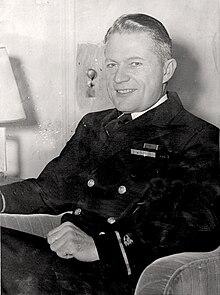George Tweed
| George Ray Tweed | |
|---|---|
 |
|
| Born |
July 2, 1902 Oregon, United States |
| Died | January 16, 1989 (aged 86) Crescent City, California, United States |
| Place of burial | Eagle Point National Cemetery |
| Allegiance |
|
| Service/branch |
|
| Years of service | 1922–1948 |
| Rank |
|
| Battles/wars | |
| Awards |
Silver Star Legion of Merit with "V" Device |
George Ray Tweed (July 2, 1902 – January 16, 1989) was a decorated radioman in the United States Navy who served during World War II. He is most famous for evading of Japanese capture for two years and seven months after the surrender of the U.S garrison on Guam in 1941.
Tweed enlisted in the United States Navy in 1922 and attended the basic training at Naval Station Great Lakes. He also attended the Radioman School and served in the various Navy radio units until 1940, when he was transferred to the Naval Base Guam.
At the time a 16-year veteran of the Navy with the rank of Radioman First Class, Tweed served in the Navy Communication Office, when the Japanese invaded the island on December 8, 1941, in the First Battle of Guam. Tweed arrived on Guam in August 1939. His family, along with other American women and children, had been evacuated in October 1941. The Americans faced the Japanese invasion with 155 Marines, a 200-man native insular force, and 400 Navy personnel who were untrained for combat. He and five other men (Al Tyson, Yeoman First Class Yablonsky, Chief Aerographer Jones, Chief Machinist's Mate Krump, and Machinist's Mate First Class Johnston of the USS Penguin) slipped into the Guam jungle rather than become prisoners of war.
When the Japanese became aware of these men on the island, they began to hunt for them. The Americans captured during the initial invasion were taken to Japan, and those captured in the jungle were to be executed. The Japanese offered 100 yen for the capture of any American but a1000 yen for Tweed because of his radio expertise. He was able to get a Silvertone radio working by March 1942, allowing him and the locals to receive news broadcast by KGEI, San Francisco. When that battery ceased operating, he used a Zenith Electronics radio to pick up also the USAFFE, The Voice of Freedom, broadcasts from Corregidor Island. Based on tho radio broadcasts, Tweed published an underground newspaper, the Guam Eagle, for four months using a typewriter and carbon paper.
...
Wikipedia
